- Sharon Hafuta
- Sep 25
- 14 min read
Updated: Sep 28
Want a portfolio that builds itself? Try Wix’s AI Website Builder →

Putting together an architecture portfolio is about juggling sketches, plans, renderings and finished work while showing your thought process and style—all in a way that makes sense to someone who’s never stepped on a construction site. Many architects struggle to make their work clear, compelling and easy to explore.
Well-planned portfolio websites fix that, letting projects speak for themselves while giving viewers a clear sense of your approach and expertise. This guide will help graduates, freelancers and experienced architects learn how to make a portfolio that highlights their work and use a website builder to bring it to life.

Showcasing your talent should be easy. With Wix’s portfolio builder, you can create a professional, eye-catching portfolio that shows your best work in just a few clicks. Wix’s customizable templates and easy-to-use tools let you present your skills with confidence–leaving a lasting impression on anyone who visits your site.
Creating a high-impact architecture portfolio used to take weeks. But thanks to AI website builder, you can now launch a sleek, customized portfolio in just hours. With Wix AI, you get intuitive design tools, industry‑ready features and built‑in SEO, plus AI-powered support to help you bring your portfolio to life without writing a single line of code.
TL;DR: how to make an architecture portfolio
Your portfolio shows your work, process and design style. Start by defining who it’s for, then pick 5–10 strong projects and organize them with visuals, sketches and short explanations. Include About, Projects and Contact pages and add blogs or case studies if useful. Keep layouts clean, storytelling clear and images high-quality. Optimize for search, test your site, publish it and update regularly to stay visible and credible.
Learn more: What is a portfolio, Why do I need a portfolio?
Architecture service type | Portfolio best practices |
|---|---|
Residential architecture | Emphasize lifestyle and personal touch. Use photo galleries showing interiors, exteriors and before-and-after shots. Highlight design process and client stories to make projects relatable. Include clear contact options for inquiries. |
Commercial architecture | Show functionality, scale and innovation. Use categorized galleries for offices, retail or public spaces. Highlight problem-solving, project impact, and measurable results. Include strong calls to action for consultations. |
Landscape architecture | Focus on transformation and context. Display aerial shots, renderings, and plant or material details. Tell the story of environmental integration and sustainability. Use immersive visuals to capture experience of space. |
Interior design | Highlight atmosphere and material choices. Use interactive sliders, mood boards and detailed room photography. Show process notes on color palettes, lighting and furniture selection. Make consultation booking easy. |
Urban design / master planning | Emphasize vision and strategy. Include maps, diagrams and phased timelines. Show how your designs shape communities, improve flow, or respond to urban challenges. Use storytelling to connect scale with impact. |
Sustainable / green architecture | Showcase eco-friendly innovation. Highlight energy-efficient systems, certifications, and green materials. Include measurable impact, project narratives and visual icons for quick comprehension. |
Industrial / infrastructure | Focus on technical precision and efficiency. Include structural diagrams, workflow layouts and problem-solving examples. Emphasize durability, functionality and innovative engineering solutions. |
Renovation / restoration | Show craftsmanship and respect for history. Use before-and-after visuals, detailed notes on materials and methods. Highlight preservation challenges and creative adaptations. Storytelling should convey care and expertise. |
Freelance architecture services | Highlight versatility and adaptability. Focus on diverse projects, fast turnaround, and client satisfaction. Keep layouts flexible, easy to update, with clear service offerings and contact options. |
Architecture studio / firm | Emphasize team, philosophy and signature style. Showcase a curated selection of projects, awards, and client collaborations. Use consistent branding, cohesive visuals, and navigation that guides visitors through capabilities and expertise. |
Ready to start? Get to know the best website builders for portfolios and search through hundreds of customizable free website templates.
How to make an architecture portfolio in 11 steps
Your digital portfolio is your brand, your pitch deck and your resume in one. Whether you're launching your career, starting a studio or scaling your practice, here’s how to build a standout architecture portfolio website.
01. Know your audience: design for the right clients
When planning your architecture portfolio, start by thinking about who will see it and what matters most to them. Residential projects attract clients ready to invest in thoughtful design, so make them feel livable and functional while reflecting your sense of beauty. In commercial work, efficiency, branding and smart planning take center stage, showing businesses and stakeholders the value you can deliver.
Interior projects capture attention through clever layouts and material choices that enhance the user experience, while urban and landscape designs demonstrate strategic thinking and sustainable solutions that resonate with developers and municipalities.
Experimental or conceptual projects, whether for academic audiences, competitions or award panels, reveal your innovative approach and creative thinking. These projects can also build trust and confidence with potential clients or collaborators, showing that you bring fresh ideas and real-world insight to every design challenge.
"Knowing your target audience is fundamental to crafting an effective SEO strategy. By understanding their preferences, behavior patterns and pain points, you can tailor your content and optimization efforts to resonate deeply with their needs. This targeted approach not only boosts engagement but also fosters stronger connections and loyalty among your audience." - Idan Cohen, SEO growth specialist at Wix
Tailor your strategy:
Applying to jobs? Focus on clarity, range and storytelling (see: how to make a portfolio for a job)
Building a freelance brand? Highlight service offerings (see: how to build a freelance portfolio)
Starting a firm? Treat your site as a business website, this is step one in how to start an architecture business
02. Find the perfect website builder for architects
When choosing a website builder for an architecture portfolio, think beyond basic layouts. The platform should support high-resolution images and galleries so every rendering, photo or model is displayed clearly without slowing down the site. Slideshows and interactive sections let visitors move through projects naturally, while interactive plans, 3D models, videos or virtual tours help explain complex designs that static images alone cannot show.
A variety of portfolio templates gives architects the flexibility to match the portfolio’s design to their brand and the concept behind each project. Drag-and-drop editing and customizable layouts make it easy to arrange projects, adjust typography and maintain a consistent visual hierarchy without coding skills.
Mobile optimization ensures the portfolio looks professional on any device, and performance features like fast-loading pages, image compression and built-in SEO tools make the work discoverable by clients, collaborators or employers. A strong website builder combines these capabilities, letting architects showcase creativity, technical skill and design thinking effectively.
"Choose a website builder that allows you to make fast pivots based on your business needs. If, from one day to the next, you need to add events or an online store, make sure your website builder makes that possible for you." - Esin D. Habif, product marketing lead at Wix
Why Wix works for architecture portfolios
Wix gives you design freedom, smart tools, and stunning visuals, all without code.
Drag-and-drop website builder or AI-generated layouts (ai portfolio examples)
Tools built for visual storytelling: grids, parallax, sliders, galleries
Industry-ready designs for photography portfolios, interior design portfolios and more
Explore the best website builders:
03. Pick a domain that reflects your brand

Your domain name is your digital identity, short, memorable and aligned with your brand. Wix makes it easy to search for a domain name or use its built-in domain name generator if you’re not sure what to choose.
Domain tips:
Use your full name, studio name or explore relevant architecture business names
Use Wix to learn how to register a domain seamlessly during setup
Avoid punctuation and stay on-brand (explore portfolio names)
"The best rule of thumb for choosing a domain name is to keep it short, simple and easy to remember. Long or confusing names lose people fast and make it harder for customers to find you again." - Ramzy Humsi, Founder & CEO, Vortex Ranker
04. Choose hosting that supports your portfolio
Not sure what is web hosting or how to compare providers? Wix simplifies it. Every site comes with fast, secure, free website hosting built in, no tech stress required.
Hosting benefits with Wix:
Automatic backups and website security
Free SSL certificate (helps with SEO)
Lightning-fast content delivery
"What often gets forgotten when talking about choosing a website builder is the capabilities of the infrastructure that’s promised to you—the reliability of the hosting, the level of security in place to protect your visitors’ data and, of course, your site's speed. Even if infrastructure is not the first thought that comes to mind when creating a website, if it’s not robust enough, it can cause major headaches for website owners when trying to scale a website later on." - Esin D. Habif, product marketing lead at Wix
05. Select a template that showcases your work
When selecting a template, think of it as the framework for how your work will be experienced. The template should guide viewers naturally through your projects while reflecting your architectural style. For clean, professional projects, minimalist layouts with clear spacing and subtle typography work best, letting the work speak for itself. For conceptual or experimental work, consider templates that allow creative arrangements, asymmetrical grids or bold visual elements that highlight innovation.
Flexibility is key. The template should let you mix different types of content from process sketches and diagrams to final renders without breaking the design. Sections should be adaptable so you can emphasize storytelling for each project, integrate context or client information and maintain visual consistency across the portfolio.
Beyond aesthetics, the right template helps communicate your design philosophy, reinforces your personal or firm brand and ensures every project is presented in a way that feels deliberate and curated.
"An outstanding portfolio is all about storytelling. It’s not just a showcase of work but a narrative that weaves together a professional’s skills, creativity, and personality. Features like dynamic presets, AI setup and beautiful templates let creators bring their stories to life, ensuring that every portfolio not only stands out for its aesthetic appeal but also tells a compelling story about the creator behind it." - Hani Safe, product lead at Wix
Explore free architecture templates:
06. Customize your portfolio with style
After choosing a template, the real work begins in making it reflect your unique design style. Start with visual elements: adjust colors, fonts and spacing to create a consistent aesthetic that complements your work rather than competing with it.
Consider how each section flows into the next—your homepage should introduce your approach, project pages should balance images and explanations and process sections should guide viewers through your design thinking.
Customization also includes the content itself. Highlight standout projects, add sketches, diagrams, 3D models or behind-the-scenes notes and show the narrative behind each design decision. Use layouts that allow you to mix media types without cluttering the page and think about hierarchy so important work catches attention first. Small details like consistent typography, subtle visual cues and intuitive navigation make the site feel polished and professional.
Not sure where to begin? Wix includes a logo maker to help you craft a consistent visual identity or explore tutorials on how to design a logo.
Customization features:
Use scroll effects, grid layouts and animation to bring your work to life
Match your design system across pages for professional consistency
Use Wix AI tools to auto-generate text and layouts if you're stuck
07. Add pages that highlight your projects and process
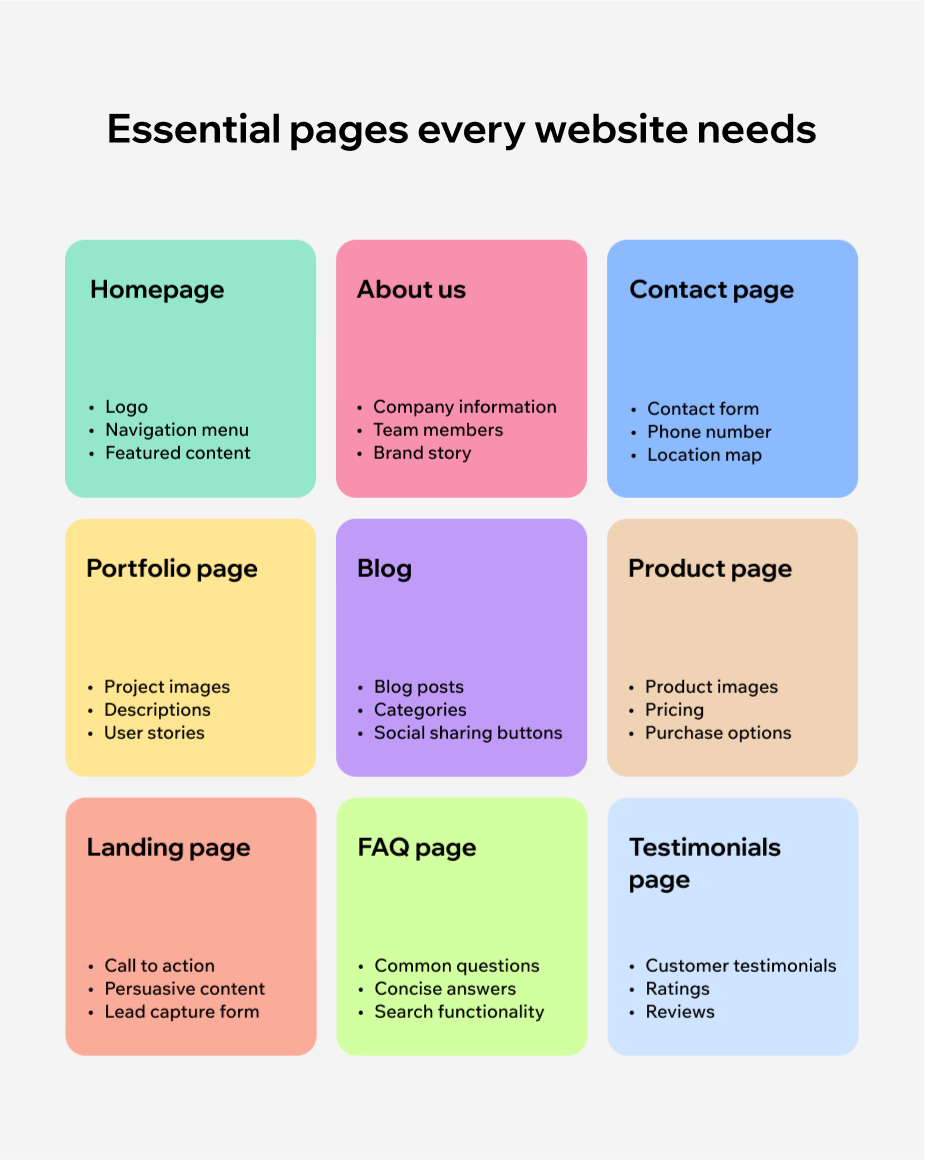
These core pages are essential for credibility, user experience and conversion. Wix templates include these by default, just plug in your content.
Recommended pages:
About us: Tell your story
Projects: Include strong case studies with visuals and descriptions
Contact us pages: Offer forms, clickable emails or online scheduling options
Process/work in progress: Show sketches, diagrams, models or concept development to highlight your design thinking.
Services/offerings: Outline what types of architecture or design services you provide for clients or collaborators.
Awards & recognition: Highlight competitions, grants, publications or exhibitions to build credibility.
Blog: Share design ideas, project updates or industry commentary to demonstrate expertise and improve SEO.
Testimonials/clients: Include feedback from past clients, collaborators or professors to add social proof.
Media/press: Showcase articles, interviews or features that mention your work.
Downloads/resources: Provide downloadable PDFs of your CV, portfolio or project sheets for employers or clients.
Learn more:

08. Create engaging content
Strong visuals are a must—but content keeps people on your site and tells the story behind your work. Use Wix's blog maker to add case studies, articles or personal updates.
Content ideas for architects:
Start a blog: learn how to start a blog or more specifically how to start an architecture blog
Establish your expertise: Share project insights, design tips or industry trends to show your knowledge and build trust with clients and collaborators.
Project highlights: Break down individual projects with challenges, solutions and key design decisions.
Video walkthroughs or time-lapses: Show construction phases, model making or virtual tours to give a dynamic perspective.
Client stories or case studies: Share how your work solved real problems for clients or communities.
Tips and tutorials: Offer advice on design, drafting, or architectural tools to position yourself as knowledgeable and approachable.
Industry insights or trends: Discuss new materials, sustainability strategies or urban design developments to show awareness of the field.
Personal reflections: Write about your inspirations, design philosophy or lessons learned from projects to make your portfolio more relatable.
Collaborations and team work: Highlight joint projects and your role to demonstrate versatility and teamwork.
09. Be discovered: SEO for architects

If you're serious about being found, SEO matters. Wix walks you through keyword suggestions and on-page improvements as you build.
SEO must-dos:
Add alt text and image titles
Use keywords like digital portfolio examples, website architecture and how to make money as an architect
Link to your blog and project pages for internal linking strength
"Leveraging SEO and integrating it into the website creation process is vital. Various studies have shown that organic search is the single greatest provider of traffic to websites, which is even more pronounced in the B2B context. Additionally, traffic from organic search, when done correctly, is essentially built to last (with proper maintenance over time, of course) and forms a crucial part of a site’s long-term growth." - Mordy Oberstein, head of SEO branding at Wix
10. Test and publish
Once your content is in place, preview your site on desktop and mobile. Check image speed, layout responsiveness and calls to action.
Testing checklist:
Test contact forms and menu links
Confirm mobile layout isn’t cutting off images or buttons
Run a quick SEO check using Wix’s built-in tools
11. Stay relevant: maintain your portfolio
Your portfolio isn’t static. Keep it current by updating projects, adding new content and promoting it through the right channels.
Ideas for ongoing growth:
Add project blogs
Share updates on social and through your newsletter
Continue optimizing for visibility with smart marketing strategies
Architecture portfolio website examples built with Wix
01. EMC2 Architecture LLC

EMC2 Architecture LLC's homepage presents a striking grid of high‑resolution project images balanced with clean white space. The projects are categorized by typology, making website navigation intuitive.
Minimalist web design with focus on visuals
Structured grid layout that highlights key projects
Parallax scrolling adds depth
Inspired? Here’s the exact Wix website template behind this architecture website.
Template name: Construction company website template
Pro tip: Don’t stress about template names, they’re just starting points. You don’t need an “architecture” template to build an architecture site. Any design can work as long as it fits your layout, content and style.
02. Allen Pepa Architects

Allen Pepa Architects's portfolio uses a full‑width slideshow on page one to pull in viewers, followed by curated gallery categories and a clean about section.
Engaging full‑page slider intro
Clear categorization of residential vs commercial work
Focus on narrative and process through case study pages
Inspired? Here’s the exact Wix website template behind this architecture website.
Template name: Marketing agency website template
03. Philip Ewald

Philip Ewald’s architecture portfolio emphasizes storytelling, every project includes sketches, plans, renderings and finished photography.
Comprehensive visual narrative per project
Hover‑reveal project titles for interactive feel
Integrated contact CTA after each project
Inspired? Here’s the exact Wix website template behind this architecture website.
Template name: Architecture firm website template
04. John R Mastera + Associates Architects

Mastera Architects' portfolio website strikes a balance between modern minimalism and timeless elegance. The homepage uses a full-screen image carousel to immediately draw visitors into their world, with subtle hover states that reflect attention to detail.
Full-screen visuals that let the work speak for itself
Scroll-based animations that add polish without distraction
Strong “About” section that outlines both philosophy and experience
Inspired? Here’s the exact Wix website template behind this architecture website.
Template name: Photography forum website template
05. Redditt Architecture

Redditt Architecture’s site presents a calm, confident aesthetic that mirrors the studio’s architectural style. The homepage is understated but strategic, with a grid of project thumbnails that immediately conveys depth and variety.
Focus on project photography, with minimal distractions
Subtle hover interactions and scroll pacing add polish
Simple contact and about sections that build trust without overselling
Inspired? Here’s the exact Wix website template behind this architecture website.
Template name: Residential architecture website template
Learn more:

Why architecture professionals choose Wix
Architecture professionals need websites that can:
Showcase high‑resolution images without slowing down
Offer custom layout flexibility to match visual identity
Highlight storytelling, from sketches to finished builds
Integrate online forms, bookings or online orders
With Wix, architects can take advantage of these features:
AI Website builder generates layouts and text tailored to architecture needs
Wix Images handles high-quality imagery with lazy loading
Architecture portfolio website template geared toward architects, with sections for project galleries, about, contact
Built‑in SEO features, mobile‑optimized design, and hosting included
Online store supports services or merchandise sales
How to make an architecture portfolio FAQ
What's the best template on Wix for architecture portfolios?
Choose from over 2000 free website templates on Wix, including the best templates that architects use, like an architecture firm website template or interior design website templates. Wix's templates are built for large image galleries, narrative sections and clean layouts.
How many projects should I include in my architecture portfolio?
Include 5–10 projects in your architecture portfolio, balancing variety and depth. Feature 3–5 of your strongest projects with full process and final designs, add 1–2 personal or experimental projects to show creativity and include 1–2 smaller or supporting projects to demonstrate versatility.
How can Wix help with SEO for my architecture portfolio?
Wix’s built-in SEO guides you through metadata, structured data, mobile optimization and page speed enhancements to help your site rank for keywords like “architecture portfolio” and “architect website builder”.
What sections should an architecture portfolio include?
Include an introduction about yourself, your standout projects, process work and a contact section. Add optional sections like awards, publications or client testimonials to strengthen credibility. Keep the layout clean so viewers can focus on your work.
How do I show my design process in a portfolio?
Include sketches, diagrams, models and iterations alongside finished projects. Write short captions explaining your decisions and challenges. This gives viewers insight into how you think and problem-solve.
How do I get my architecture portfolio found on Google?
Use descriptive titles, headings and metadata that include relevant keywords like “architecture portfolio” or your specialty. Optimize images with proper alt text and compress them for faster loading. Adding a blog or project updates can also improve search visibility.
What file formats are best for portfolio images?
Use JPEG or PNG for high-quality images that load quickly. For sketches or vector work, PDF or SVG can preserve clarity. Keep file sizes optimized to balance quality and performance.
How should I structure my portfolio for mobile users?
Use a simple vertical layout with easy-to-tap navigation. Ensure images scale correctly and text remains readable on smaller screens. Avoid heavy animations that slow down mobile performance.
How do I make my architecture portfolio load quickly online?
Compress images and use modern formats like WebP for faster loading. Limit large files, reduce unnecessary scripts and use a reliable hosting solution. Fast load times improve user experience and SEO.
What to write in an architect bio?
An architect bio should include your name, title and design specialty. Highlight your experience, notable projects, awards or education and share your design philosophy in a clear approachable way. End with a personal touch or how people can contact you.
Free portfolio templates on Wix:



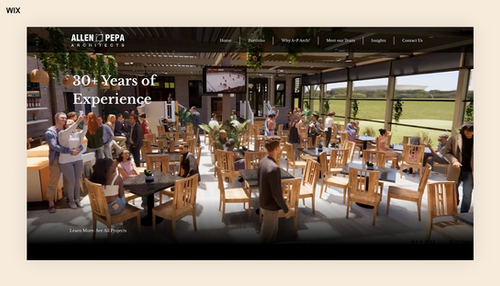












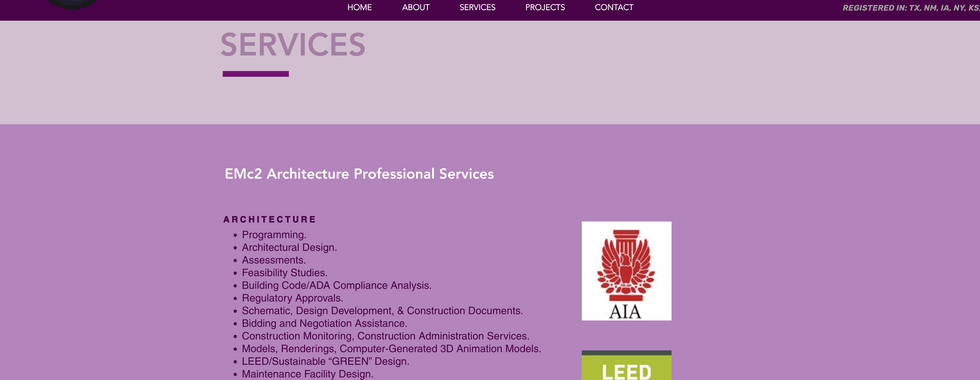






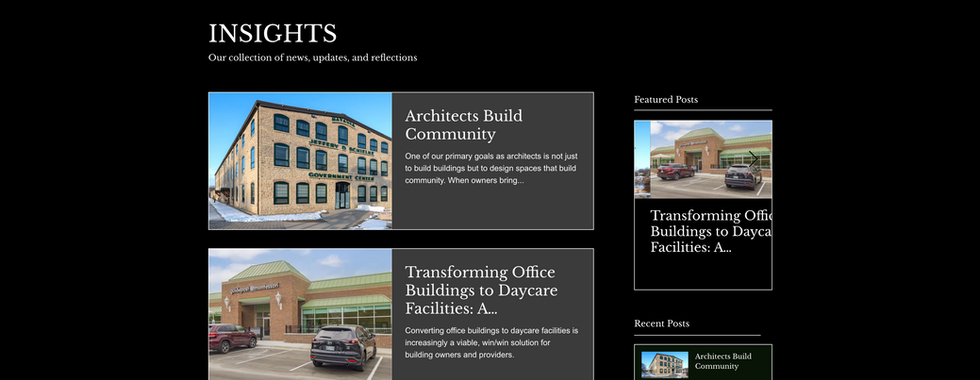





















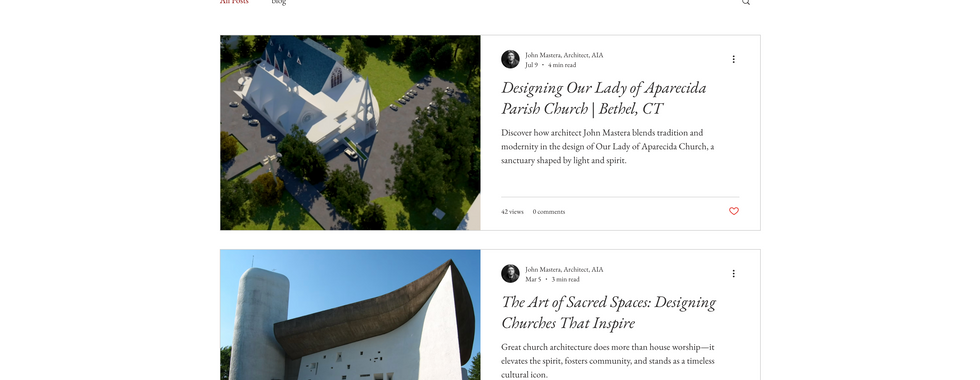















Comments